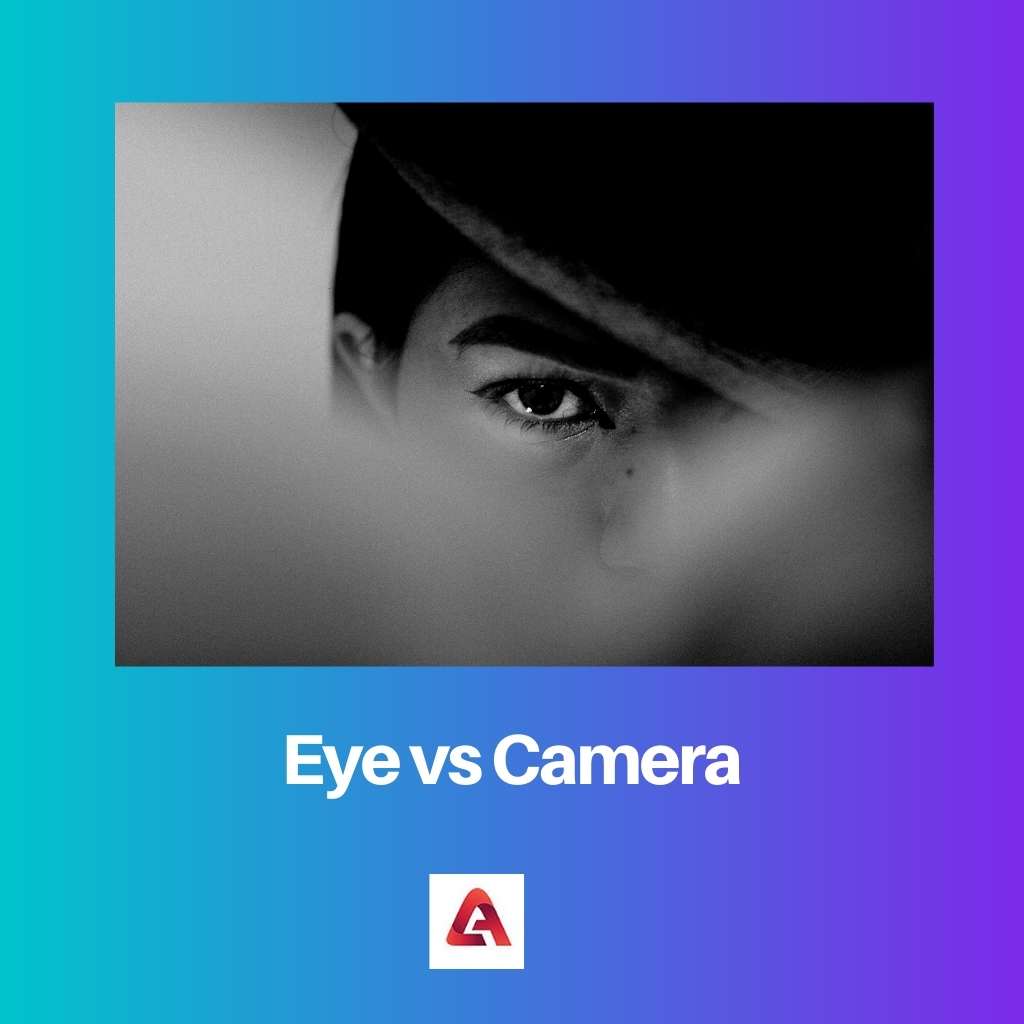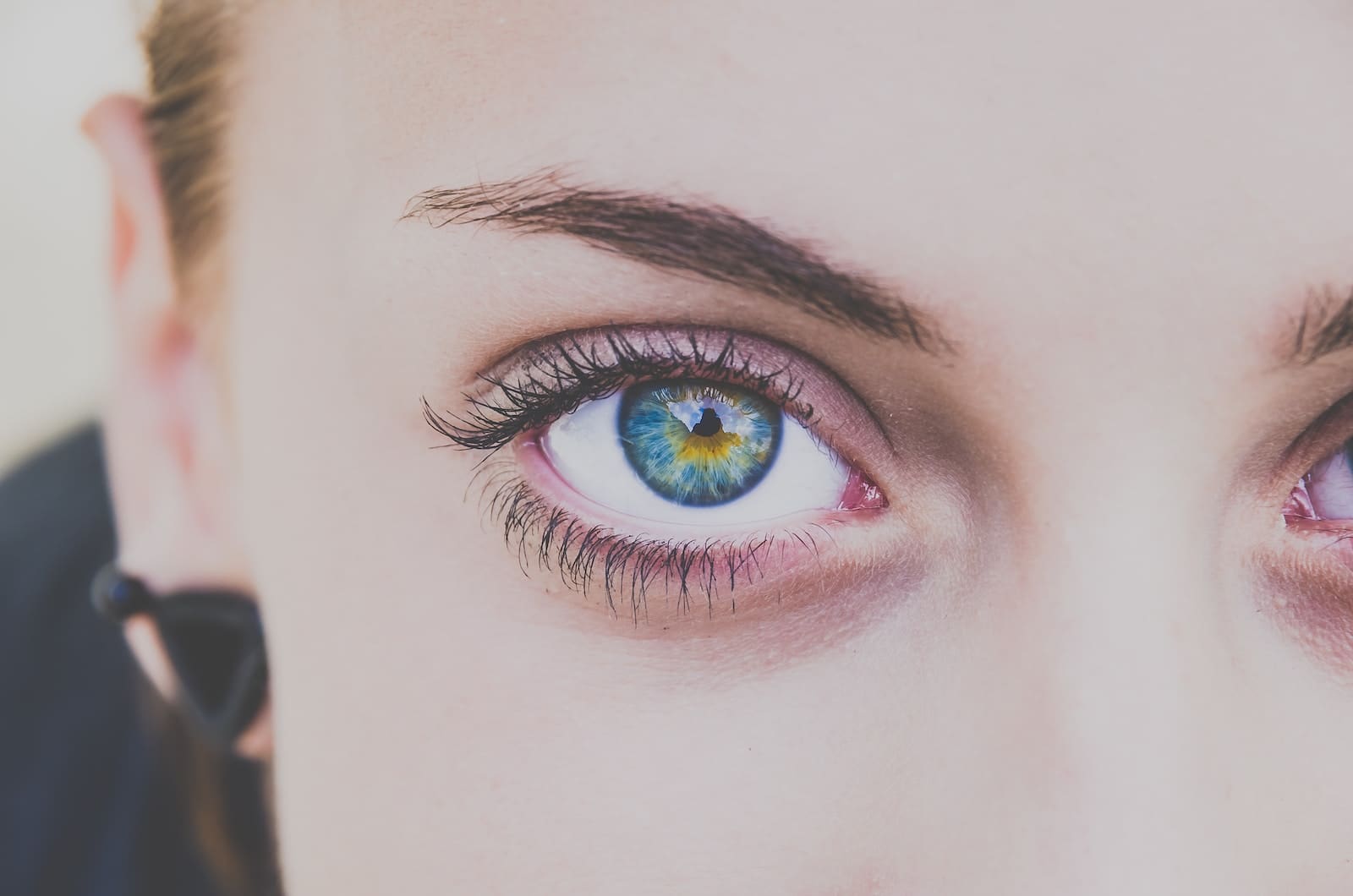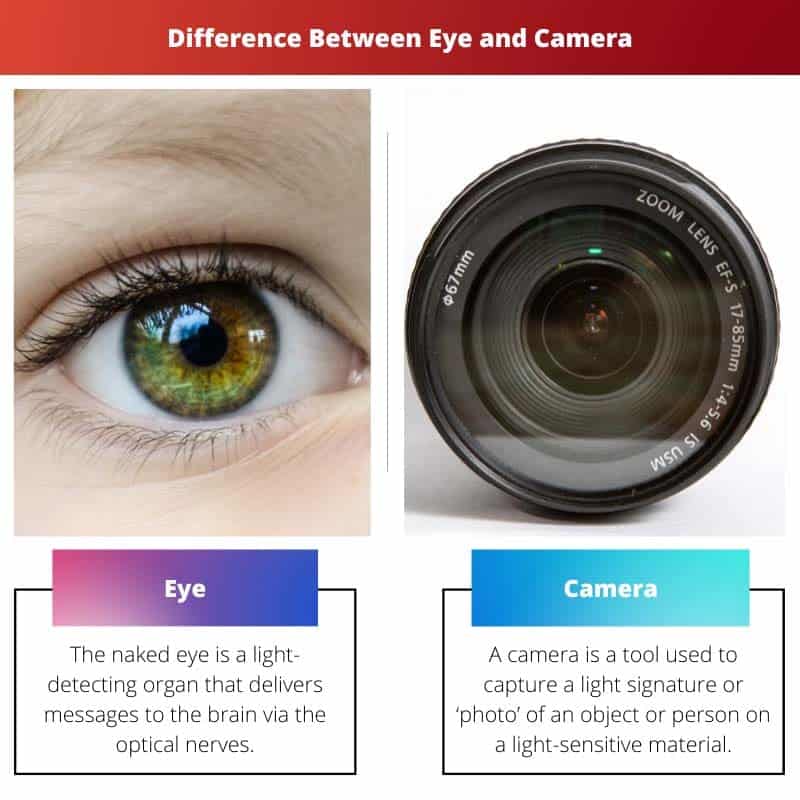Our eyes can gaze around and adapt dynamically based on their surroundings. As a result, most of us believe that there is little-to-no difference between the human eye and a camera.
However, things are far more difficult than they appear. We must recognize that there are two major disparities in how they operate.
These distinctions can be summarized: There is a distinction between concentrating on a picture and interpreting color. This article highlights all of the distinctions in the structure and functioning of an eye and a camera.
Key Takeaways
- The human eye can adjust to a wider range of light conditions and has better depth perception than a camera.
- Cameras can capture and store images at higher resolutions indefinitely, while the eye relies on the brain for image processing and memory.
- The eye uses a lens and retina to focus and detect light, while a camera uses a lens and image sensor for the same purpose.
Eye vs Camera
The eye is a natural optical system that allows us to see the world around us. It works by allowing light to enter through the pupil, which is controlled by the iris to regulate the amount of light that enters. A camera is an artificial optical system that mimics the eye’s functions. It works by using a lens to focus light onto a light-sensitive surface such as film.

The naked eye is a light-detecting organ that delivers messages to the brain via the optical nerves.
Your eye, which is among the most complicated organs in the entire body, is made up of many different components, each of which contributes to your capacity to see.
And, by far it is astonishing to know that none of the cameras in the world can actually compete with the eye itself!
In photography as well as cinematography, a camera is a tool used to capture a light signature or ‘photo’ of an object or person on a light-sensitive material; it is simply a light-tight box with just an aperture that allows light to be focused onto a sensitized film or plate.
Photography is a scientific as well as an artistic approach, but many people don’t comprehend what occurs when they press the camera’s shutter button or open the phone’s camera app. A camera is a tool for capturing or recording images.
Comparison Table
| Parameters of Comparison | Eye | Camera |
|---|---|---|
| Structure | The eye is composed of three coats that surround the optically transparent vitreous humor, cornea, and retinal body. The cornea as well as sclera form the exterior coat; the choroid, ciliary body, plus iris form the intermediate coat, which provides the primary circulatory system to the eye and extends from the rear to the front. | A camera is a tool used to capture a light signature or ‘photo’ of an object or person on a light-sensitive material; it simply is a light-proof box with lenses and mirrors. |
| Functions | To see and process images via the brain. | To capture and ‘record’ light signatures of any subject. |
| Blind Spots | The eyes have blind spots where the optic nerves connect to the retina. | Camera has no blind spots. |
| Dimensions | The eye sees in 3 dimensions, length, width and height. | The camera records in 2D. |
| Color Detection | The color detection in eyes is done by rods and cone cells. | The color detection in camera is done by photosites. |
What is Eye?
The eye is a sensory organ that responds to light and allows us to see. Rod and cone cells in the retina are photoreceptor cells that detect visible light and transmit it to the brain.
The eyes provide information to the brain, which allows it to perceive color, shape, depth, movement, and other characteristics. The sensory nerve system includes the eye.
The non-image-forming hypersensitive ganglion photoreceptor cells of the human eye, like those of other animals, absorb light signals that regulate pupil size adjustment, melatonin control and suppressing, and circadian rhythm synchronization.
The eye is not a flawless spheroid, but instead, a fused two-piece entity made up of an acute (front) portion and a posterior (back) region. The cornea, pupil, and lens comprise the frontal section.
The cornea is much more translucent and arched, and it connects to the bigger posterior chamber, which is made up of the aqueous humor, retina, choroid, and the external white protective shell known as the sclera.
The cornea is 11 mm in diameter and 0.5 mm thick at the center.
The cornea (among the most important parts of the eye) is also densely packed with neurons that warn us of aggravations and irritations that may endanger our eyesight and visual acuity. Furthermore, the cornea is vulnerable to damage.
Scratches, or “scrapes” to the cornea’s membrane, are common injuries. Minor corneal scrapes normally heal on their own, but more serious injuries can result in discomfort and, in rare cases, corneal scarring.

What is a Camera?
A camera lens gathers and reflects light, so how is that data stored? Photographers were formerly scientists in their own right. Light-sensitive materials were used to manufacture film.
When those substances were exposed to light from the lens, they caught the form of the items as well as details such as how much light was reflected off of them and such.
The film which was exposed to light is placed in a sequence of biochemical baths in the darkroom to finally generate the picture.
Photosets are used by cameras to gather light. A conventional camera contains a large number of these light collecting elements, which gather light and transform it into signals that electronic systems can read.
Furthermore, cameras employ screens that divide light into its fundamental colors – red, blue, and green. By blending these colors, it creates a complete picture.
A camera captures in two dimensions, but the eye perceives in three. This implies that when we look at anything, we notice its height, breadth, and depth. We can only observe length and width using a camera.
Because a photograph is a flat medium, there is no way to have depth in the image. This is mostly accomplished through the eye’s stereo vision.
Trying to bring the forefingers of both the hands together from the edges is a basic instance of this. This is considerably easier to achieve with both eyes wide open than with just one, and it’s nearly impossible with a camera.
In summary, a camera is a light-proof container with an opening coupled with a lens as well as a shutter whereby the image of an item is transmitted onto a surface for capturing (as on a photographic film or an electronically aided sensor) or conversion into electric signals.

Main Differences Between Eye and Camera
- The eye is composed of natural nerves and organic components whereas a camera consists of artificial materials and components.
- An eye cannot record images whereas a camera can do so.
- An eye does have blind spots where the optic nerves connect to the retina whereas a camera does not have any blind spots.
- In an eye, the pupil controls the focus whereas, in a camera, the lens controls the focus in an object or a human.
- Eyes have rods and cones to receive the color accuracy of an image whereas in a camera photosets do the same job.
- Eyes process the 3d image of any subject whereas a camera can only record in 2d.


It’s fascinating to see how much more advanced the human eye is as a natural optical system compared to a camera. The complexity of the eye and its ability to adjust to various light conditions while maintaining depth perception is amazing.
Humans often overlook the intricacy of the eye’s design and its natural ability to process visual information. The comparison to a camera helps highlight the unique features of the human visual system.
The human eye’s structure and functionality, as described in the article, shed light on its remarkable ability to perceive the world in three dimensions and interpret complex visual data. It’s truly fascinating.
The detailed explanation of how the eye and camera function differently is quite informative. It provides a great insight into the complexities of the human eye and the artificial nature of cameras.
It’s intriguing to consider the fundamental differences between the eye and the camera. The detailed insights provided in the post offer a thought-provoking perspective on how we perceive and capture the world around us. The complexities of vision are truly remarkable.
Although the comparison between the human eye and a camera is valuable, it’s essential to remember that each serves its unique purpose. While a camera excels in capturing and preserving images, the human eye offers unparalleled visual perception and cognitive processing.
The post presents a compelling analysis of the structural and functional disparities between the human eye and a camera. The technological advancements of cameras are impressive, but the complexity and adaptability of the human eye remain unparalleled.
There are some significant differences between the functioning of the human eye and that of a camera. While they both have their strengths and weaknesses, the comparison table provides a clear understanding of how their structural and operational differences affect the way they ‘see’ and process information.
I agree, the post provides a deep understanding of the differences between the human eye and the camera, and it is important to recognize and appreciate the complexity of both.